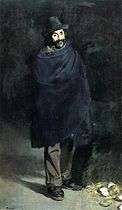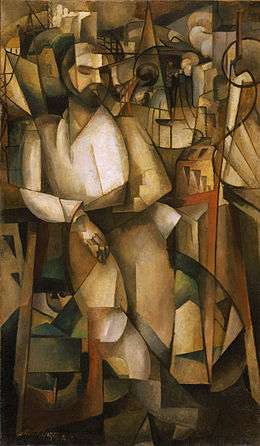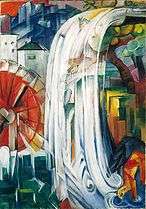Arthur Jerome Eddy
Arthur Jerome Eddy (November 5, 1859 in Flint, Michigan- July 21, 1920 in New York City, New York) was an American lawyer, author, art collector, and art critic.
Arthur Jerome Eddy (also referred to as Arthur J. Eddy) was a prominent member of the first generation of American Modern art collectors. His book Cubists and Post-Impressionism was the first American book promoting these new art movements and the work of Wassily Kandinsky.[1] As opposed to the other early American collectors of modernist works, who were interested in French modernism almost exclusively, Eddy also collected the work of the German expressionists and Wassily Kandinsky. He is also known for his support of the Armory Show, purchasing work from the show in New York and Chicago and lecturing on the art during the Chicago show.[2] In 1931, a portion of Eddy's collection was donated by his widow and son to the Art Institute of Chicago as the "Arthur Jerome Eddy Memorial Collection" which is an important core of the Museum's collection of Modern art.[3]
Family
Arthur Jerome Eddy is the son of Jerome Eddy, Mayor of Flint Michigan and Consul to Canada. His father purchased the Flint Michigan paper, the Genesee Democrat. After running the paper himself, Jerome Eddy turned over management of the paper to Arthur Jerome Eddy.[4] Arthur J. Eddy married Lulu Crapo Orrell, a granddaughter of Michigan Governor Henry H. Crapo[4] and cousin of the founder of General Motors, William Crapo Durant.[5] His son, Jerome Orrell Eddy was born May 12, 1891 and died December 28, 1951.[6]
Homes
The family lived at 4152 N. Sheridan in Chicago, Illinois.[7][8]
The family maintained a second home in Pasadena designed by Frederick Roehrig in 1905. The house was cited as "the most complete example of the California (Southern Californian!) interpretation of Arts and Crafts principles."[9] William Le Baron Jenney wrote an article, "A Remarkable Dwelling," about the Eddy House in the May 1906 Inland Architect and News Record.[9] An article about the house was published in The Craftsman magazine.[10] The house was "one of the most important bungalow designs of the period, strongly influencing later ranch style houses throughout California and later the United States."[11] The Pasadena house was torn down in 1973.[12]
Education
One source says that Eddy graduated from the "literary department" of Harvard University.[4] A second source indicates that he "entered Harvard Law School in 1877 but in 1879 returned to be publisher of the Genesee Democrat newspaper. He continued studying law with a local expert. In 1888 he moved to Chicago to begin his legal career, passing the Illinois Bar in 1890."[1]
Business career
Mr. Eddy practiced corporate law with Wetten, Matthews & Pegler,[1] which later became the firm of Eddy, Wetten & Pegler.[13] Mr. Eddy was one of the driving forces in creating the National Carbon Company which combined multiple carbon companies into one company that controlled approximately 75% of the US carbon market in the world.[14] Carbon was used to make numerous products related to the use of electricity.[15] He helped organize American Steel Foundry Corporation, National Turbine Company, and American Linseed Oil Company.[16] He helped established the Bridge Builder's Society.[17]
Books and Writings
He wrote on a variety of subjects and in various formats. These included "2000 Miles on an Automobile" (Travelog), "Law of Combinations" (economics), "Tales of a Small Town" (short stories), "Ganton & Co." (a novel) and "The Warning" (a play).[16] He wrote several very important books on art including "Delight, the Soul of Art", "Recollections of James McNeill Whistler", and "Cubists and Post Impressionism."
He wrote an article on tile roofs that appeared in Gustav Stickley's magazine, The Craftsman. He contributed poetry and edited a Chicago literary magazine, Contributors' Magazine, which was the self-published work of the Contributor's Club. Members of the club included Eugene Field, Harriet Monroe, George P. Upton, Potter Palmer, and John J. Glessner.[18]
Automobiles
—Arthur Jerome Eddy, 1902[19]
Mr. Eddy was an early automobile enthusiast. The New York Times reported that he set a record in automobile travel by traveling 2900 miles in two months. The trip started in Chicago on August 1, 1901. He traveled to Boston and returned to Chicago on September 30, 1901.[20] He wrote about this trip in his 1902 book, "Two thousand miles on an automobile; being a desultory narrative of a trip through New England, New York, Canada, and the West" [21] under the pseudonym of "A. Chauffeur." He drove a Winton Motor Carriage Company automobile in the 1901 trip. In 1902, he drove a Panhard to Flint Michigan to visit family and gave Margery Durant, the daughter of William Crapo Durant, her first automobile ride.[22] Her father, the future founder of General Motors, responded: “Margery, how could you, how could you, be so foolish as to risk your life in one of those things.” [23]
Art Collector and Patron
His interest in art did not awaken until he saw the World Columbian Exposition in Chicago, where he was most taken with the work of James McNeill Whistler and Auguste Rodin. Eddy, who traveled to Paris in the middle of the 1890s, was portrayed by Whistler in the painting Arrangement in Flesh Color and Brown: Portrait of Arthur Jerome Eddy. Around the same time Rodin also sculpted a portrait bust of Eddy, bronze casts of which are in the Musée Rodin in Paris, the Art Institute of Chicago, and the Albuquerque Museum of Art and History. In 1902 his first book about art, titled Delight, the Soul of Art, was published. In the following year he published Recollections and impressions of James A. McNeill Whistler. Thus through 1912 he focused on the art of the late 19th century.
For Eddy, as for many Americans, the 1913 Armory Show proved a revelation of Modern art. Fascinated by the efforts of these artists, he immediately began his collection of Avant-garde art with the purchase of a Brâncuși sculpture and 25 paintings. "In New York, Eddy purchased 15 of the most radical works on display, including Marcel Duchamp's Portrait of Chess Players (1911) and The King and Queen Surrounded by Swift Nudes (1912), Albert Gleizes's Man on a Balcony (1912), and Francis Picabia's Dances at the Spring (1912). In Chicago, he purchased three additional paintings by the Portuguese artist Amadeo de Souza Cardoso, as well as three lithographs by Maurice Denis and four by Édouard Vuillard." On two occasions during the show, Mr. Eddy lectured on "Cubism" at the Art Institute of Chicago.[24]
On trips to London and Germany he came to know of Wassily Kandinsky and by 1920 had bought four of his paintings. Kandinsky introduced Eddy to another artist in working in Munich at the time, Albert Bloch. Eddy would become Bloch's most important collector, owning over forty paintings and etchings.[25] Eddy's collection in modern art would grow to over 100 works of art.
1914 saw the publication of perhaps his most important writing, Cubists and Post-Impressionism,[26] a large portion of which was based on information that Eddy obtained from the artists themselves. It is considered to be the first work published in the United States in which Modern Art was presented and explained sympathetically. Additionally it was the first adequate account of Kandinsky in America; the artist had been represented by only one painting in the Armory Show the year before.
In his last years of life Eddy shifted the focus of his collecting to the American moderns, including some paintings by artists such as Arthur Dove.
Death
He died after surgery for acute appendicitis at Post Graduate Hospital in New York City.[16]
In 1921, Louis Sullivan designed a "family memorial enclosure" with the "Dimensions: ca: 51' (diameter)" in Glenwood Cemetery in Flint Michigan which was not built.[27]
Memorial Collection
After his death in 1920, some of the collection was dispersed. The Art Institute of Chicago exhibited his collection September 19 to October 22, 1922. In 1931, his widow and son donated 20 paintings and 3 sculptures to the Art Institute of Chicago to form the Arthur Jerome Eddy Memorial Collection. as described below.[3]
The collection includes 19th Century works:
- Édouard Manet - A Philosopher (Beggar with Oysters) (1865)
- Winslow Homer - Coast of Maine (1893)
- James Abbott McNeill Whistler - Portrait of Arthur Jerome Eddy (c. 1896)
The collection is noted for containing members of the German Der Blaue Reiter (The Blue Rider) movement:
- Gabriele Münter - Still Life with Queen (1912)
- Franz Marc - The Bewitched Mill (c. 1912)
- Wassily Kandinsky - Trojka (1911), Landscape with Two Poplars (1912), Improvisation with Green Center, No. 176 (1912) and Improvisation No. 30 (1913)
Further artists represented in the Art Institute's Eddy collection:
- Albert Bloch - Scene from a Pantomime (1914)
- Emilie Charmy - Landscape: L'Estaque (c. 1910), (Armory Show)
- André Derain - Forest at Martigues (c. 1908), (Armory Show)
- Amadeo de Souza Cardoso - Leap of the Rabbit (1911)(Armory Show), Marine Pont L'Abbe (1911), (Armory Show), and Stronghold (Armory Show - Chicago only)
- Maurice de Vlaminck - Rueil (c. 1912), (Armory Show - Chicago)
- André Dunoyer de Segonzac - The Pasture (c. 1912), (Armory Show)
- Robert Genin - Thirst (1913)
- Auguste Herbin - House and Flowering Cherry Trees: Hamburg
- Eugène Zak - The Shepard (Armory Show)
The sculpture in the collection are:
- Constantin Brâncuși - Sleeping Muse (1910), (Armory Show)
- Auguste Rodin - Mask of the Man with the Broken Nose (1864) and Arthur Jerome Eddy (Portrait Bust), (1898)
Paintings from Eddy's collection
 Édouard Manet:
Édouard Manet:
A Philosopher (Beggar with Oysters) Albert Gleizes, 1912, L'Homme au Balcon, Man on a Balcony (Portrait of Dr. Théo Morinaud). Purchased from the Armory Show
Albert Gleizes, 1912, L'Homme au Balcon, Man on a Balcony (Portrait of Dr. Théo Morinaud). Purchased from the Armory Show Winslow Homer:
Winslow Homer:
Coast of Maine Franz Marc:
Franz Marc:
The Bewitched Mill
Bibliography
- Come Let Us Reason Together: The Tariff, Facts and Figures for the Laborer, the Farmer, the Manufacturer. The Eddy printing and publishing house, Flint, Michigan c. 1884
- A Plain Talk to Farmers about the Tariff. Flint, Michigan 1984
- The Farmer's Complete Encyclopedia: A compendium of practical information on all subjects relating to the farm and household. The Eddy printing and publishing house, Flint, Michigan 1885
- The Law of Combinations: embracing monopolies, trusts, and combinations of labor and capital. Callaghan and Company, Chicago 1901
- Two thousand miles on an automobile; being a desultory narrative of a trip through New England, New York, Canada, and the West J.B. Lippincott Co., Philadelphia 1902. Originally published under the pseudonym "Chauffeur."
- Delight, the soul of art. J.B. Lippincott Co., Philadelphia 1902
- Recollections and Impressions of James A. McNeill Whistler. J. B. Lippincott Co., Philadelphia 1903
- Tales of a Small Town: By One Who Lived There J. B. Lippincott Co., Philadelphia 1907
- Tiled roofs; the kind of buildings to which they are suited and a method of construction that makes them practical as well as picturesque The Craftsman, May 1907
- Ganton & Co.; a story of Chicago commercial and social life. McClurg, Chicago 1908
- Unmask! a play, 1909
- The New Competition; an examination of the conditions underlying the radical change that is taking place in the commercial and industrial world. D. Appleton, New York 1912
- Cubists and Post-impressionism. A. C. McClurg & Co., Chicago 1914
Resources
- Art Institute of Chicago: The Arthur Jerome Eddy collection of modern paintings and sculpture. Chicago 1931
- Art Institute of Chicago: Paintings in the Art Institute of Chicago. Chicago 1961
- Distel, Anne. Les collectionneurs des impressionnistes, Amateurs et marchands La Bibliothèque des Arts, Paris 1989 ISBN 2-85047-042-2
- Dictionary of Art Historians, "Arthur Jerome Eddy"
- Robson, A. Deirdre. "Eddy, Arthur Jerome." In Grove Art Online. Oxford Art Online, (accessed February 28, 2012; subscription required).
- Sweet, Frederick A. Great Chicago Collectors in Apollo Magazine September 1966
References
- "Arthur Jerome Eddy" Dictionary of Art Historians
- The Arthur Jerome Eddy Collection of Modern Paintings and Sculptures, Part II of The Bulletin of the Art Institute of Chicago, Volume XXV, No.9, v December, 1931, Introduction by Daniel Catton Rich, p.4
- The Arthur Jerome Eddy Collection of Modern Paintings and Sculptures, Part II of The Bulletin of the Art Institute of Chicago, Volume XXV, No.9, v December, 1931, Introduction by Daniel Catton Rich, p.5
- Chapter XVI: The Press The History of Genesee County, MI.
- "The spark that created GM: Billy Durant takes control of Buick" Lawrence R. Gustin. GM Heritage Center 2006 Archived April 26, 2013, at the Wayback Machine
- "Fairview". Archived from the original on April 2, 2015. Retrieved 2013-03-23. interment.net cemetery records on-line Fairview Memorial Park, Bernalillo New Mexico, accessed March 23, 2013
- Chicago Blue Book of Selected Names for the Year Ending 1910, The Chicago Directory Company, 1909
- Uptown Chicago History, accessed March 25, 2013
- Toward A Simpler Way of Life: The Arts & Crafts Architects of California Robert Winter, University of California Press, 1997, p. 111 to 122
- A California House Modeled on the Simple Lines of the Old Mission Dwelling, Hence Meeting All Requirements of Climate and Environment The Craftsman 11, November 1906, p. 209-212
- Pacific Coast Architecture Database, Eddy, Arthur Jerome, House, Pasadena, CA ID 8924
- Wreckers hit Eddy mansion Hubbard, Harold N., Pasadena Star News, 4/26/1973
- Chicago Law Directory 1917-18, William Baldwin Sullivan, Gritman and Sullivan Publishers, 1917, p. 37
- "Big Carbon Firms Combine: Three-fourths of this Industry in the World Included" New York Times, January 10, 1899
- The Chicago Banker, Volume 1, Page 188.Chicago Banker Company 1899
- "Arthur Jerome Eddy Dies After Operation" New York Times, July 22, 1920
- Iron Age, Vol. 106, Iron Age Publishing Co. New York, July 29, 1920, p.297
- Contributors' Magazine, Vol. 1, Issues 1 and 2, Privately Printed, 1893
- Eddy, Arthur Jerome (1902). Two Thousand Miles on an Automobile: Being a Desultory Narrative of a Trip Through New England, New York, Canada, and the West (1st ed.). J.B. Lippincott Company. p. 314. ISBN 1-55709-924-3. Archived from the original on April 12, 2018. Retrieved April 12, 2018.
- "Automobile Distance Record" New York Times, October 1, 1901
- Two Thousand Miles on an Automobile, Philadelphia, London, J.B. Lippincott company (1902)
- "Billy Durant" Lawrence R. Gustin, University of Michigan Press,2008, p. 269
- "My Father" Margery Durant, G.P. Putnam's Sons, 1929
- Art Institute of Chicago Historic Exhibitions - The Armory Show, "The Cast"
- Hoberg, Annegret (1997). Albert Bloch, The American Blue Rider. Prestel. p. 67.
- Arthur Jerome Eddy, Cubists and Post-Impressionism, A.C. McClurg & Co., Chicago, 1914, second edition 1919
- Louis Sullivan: Prophet of Modern Architecture, Hugh Morrison, W. W. Norton & Company, 2001, p. 286
External links
- Works by Arthur Jerome Eddy at Project Gutenberg
- Works by or about Arthur Jerome Eddy at Internet Archive
- Arthur Jerome Eddy at the Art Institute of Chicago
- Auguste Rodin's portrait bust of Eddy, on the website of the Musée Rodin